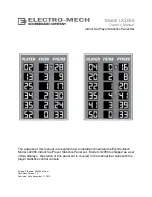
ISO-STIM 01D User Manual
_________________________________________________________________________________________________________________
___________________________________________________________________________
version 4.3
page 10
4.3. Modes of Operation
GATE TTL INPUT MODE:
In this mode the output signal is generated by the built-in timing unit. It is triggered either
manually via the MANUAL TRIGGER switch or via a TTL pulse at the GATE TTL BNC
connector. The duration of the pulse is set at the DURATION thumb wheel switch and the 3-
position range switch below. The duration time is determined by reading of the thumb wheel
switch multiplied by the factor set via the range switch. The minimum duration is 10 µs, the
maximum is 99 ms.
The amplitude of the pulse is set by the AMPLITUDE thumb wheel switch. The reading of this
switch is multiplied by 0.1 V in VOLTAGE OUTPUT MODE. In CURRENT OUTPUT
MODE the reading is multiplied by the factor set with the CURRENT RANGE switch. For
example, 250 at the thumb wheel switch will give 25 V or 250 µA (CURRENT RANGE switch
in position x1 µA) at the output plugs depending on the setting at the OUTPUT MODE switch.
If the CURRENT RANGE switch is in position x10 µA, 250 at the thumb wheel switch will
give 2.5 mA at the output plugs.
DIRECT INPUT MODE:
The signal fed into the SIGNAL INPUT connector is transformed into the isolated output signal
and amplified by a factor of ten (OUTPUT MODE: VOLTAGE), i.e. an input of 1 V will lead
to an output stimulus of 10 V. In CURRENT OUTPUT MODE the amplitude of the output
stimulus is again dependent on the setting the CURRENT RANGE switch. With the CURRENT
RANGE switch in position x1 µA, an input voltage of 1 V will result in an output stimulus of
100 µA, and with the CURRENT RANGE switch in position x10 µA the output current will be
1 mA.
The polarity switch must be in 0 position! The frequency of the input signal should not exceed
5 kHz.
ANALOG INPUT MODE:
The signal fed into the SIGNAL INPUT connector will be isolated from earth and amplified
(OUTPUT MODE: voltage) as in the DIRECT INPUT MODE. The trigger level is set to
300 mV, i.e. the input signal must have an amplitude of 300 mV or more. If the trigger level is
exceeded the input signal is transformed to the isolated output plugs, and the output stimulus
follows the input signal as long as set by the DURATION thumb wheel.
Figure 3 gives some examples how the different input modes work.
Please note that this figure does not show original recorded data. It’s for illustration only
BIPOLAR (only functional in GATE TTL mode)
The isolator is capable to generate biphasic stimuli by switching the stimulus mode switch to
BIPOLAR ON. In this mode, the stimulus that is set by the user, will be followed by a second
stimulus with the same amplitude and duration, but with reverse polarity. There is no delay
between first and second part of the stimulus. For instance, if the user sets a positive stimulus
of +1 V amplitude and 100 µs duration, this stimulus will be followed immediately by a
negative stimulus of –1 V and 100 µs duration.
































